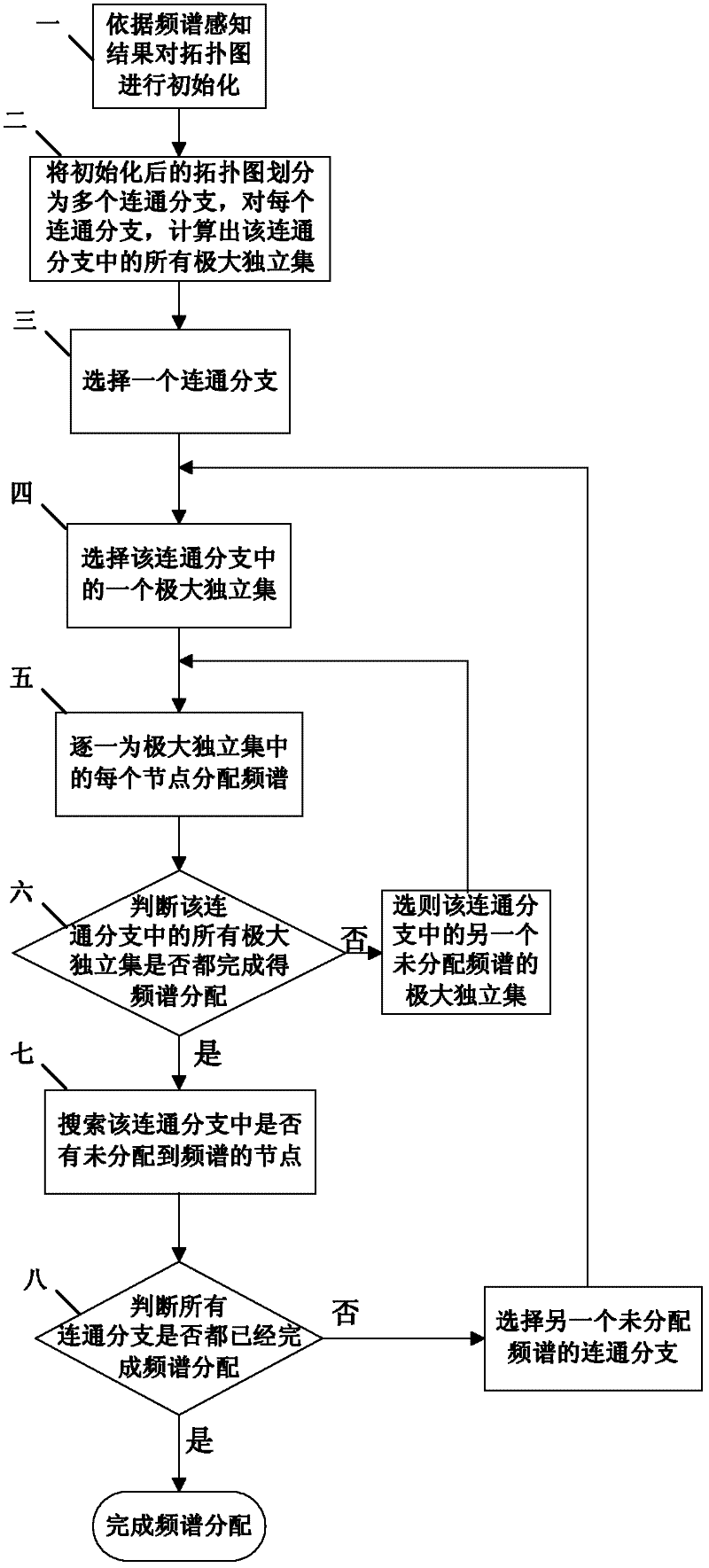Frequency spectrum distribution method based on system revenue in cognitive radio
A cognitive radio and spectrum allocation technology, applied in the transmission system, wireless communication, electrical components, etc., can solve the problem of low total system revenue and achieve high system overall spectrum revenue, fast allocation speed, and low overhead
- Summary
- Abstract
- Description
- Claims
- Application Information
AI Technical Summary
Problems solved by technology
Method used
Image
Examples
specific Embodiment approach 1
[0034] Specific implementation mode 1: The process of the spectrum allocation method based on system revenue in the cognitive radio described in this implementation mode is as follows:
[0035] Step 1: Initialize the topology map according to the spectrum sensing result.
[0036] Step 2: Divide the initialized topology graph into a plurality of connected branches, and for each connected branch, calculate all maximal independent sets in the connected branch.
[0037] Step 3, select a connected branch;
[0038] Step 4, select a maximal independent set in the connected branch;
[0039] Step 5, assigning frequency spectrum to each node in the maximum independent set one by one;
[0040] Step 6. Judging whether all the maximum independent sets in the connected branch have completed the spectrum allocation, if the judgment result is no, then select another maximum independent set in the connected branch that has not allocated spectrum, and return to the execution step Five; if th...
specific Embodiment approach 2
[0046] Embodiment 2: This embodiment is a further description of step 1 in Embodiment 1. In this embodiment, the process of initializing the topology map according to the spectrum sensing result is as follows:
[0047] Step 11, according to the spectrum sensing result, initialize the cognitive user's location coordinates, interference relationship and spectrum gain matrix;
[0048] Step one and two, according to the spectrum sensing result, initialize the authorized user coordinates and working status;
[0049]In step 13, the list of available spectrums of all cognitive users is calculated according to the location coordinates of the cognitive users and the authorized users and the working status of the authorized users.
[0050] Wherein, in step one by one, the location coordinates of the cognitive user are obtained by spectrum sensing;
[0051] The interference relation adopts the interference relation matrix L N×N ={l i,j} means that its element l i,j Indicates the inte...
specific Embodiment approach 3
[0076] Specific embodiment three: This embodiment is a further description of step 2 in specific embodiment 1. In this embodiment, the step 2 divides the initialized topology map into multiple connected branches, and the following two methods can be used :
[0077] Method 1: Calculate the connected branches according to the interference relationship of cognitive users. The specific process is:
[0078] According to the interference relationship matrix L between cognitive users N×N ={l i,j}, divide the topological graph into multiple connected branches, that is, divide all cognitive users into multiple user sets, so that there is an interference relationship between cognitive users in the same user set, and cognitive users in different user sets There is no interference relationship between them.
[0079] Method 2: Calculate the connected branches by using the method of calculating the reachable matrix with the adjacency matrix in graph theory. The specific process is:
[0...
PUM
 Login to View More
Login to View More Abstract
Description
Claims
Application Information
 Login to View More
Login to View More - R&D
- Intellectual Property
- Life Sciences
- Materials
- Tech Scout
- Unparalleled Data Quality
- Higher Quality Content
- 60% Fewer Hallucinations
Browse by: Latest US Patents, China's latest patents, Technical Efficacy Thesaurus, Application Domain, Technology Topic, Popular Technical Reports.
© 2025 PatSnap. All rights reserved.Legal|Privacy policy|Modern Slavery Act Transparency Statement|Sitemap|About US| Contact US: help@patsnap.com



